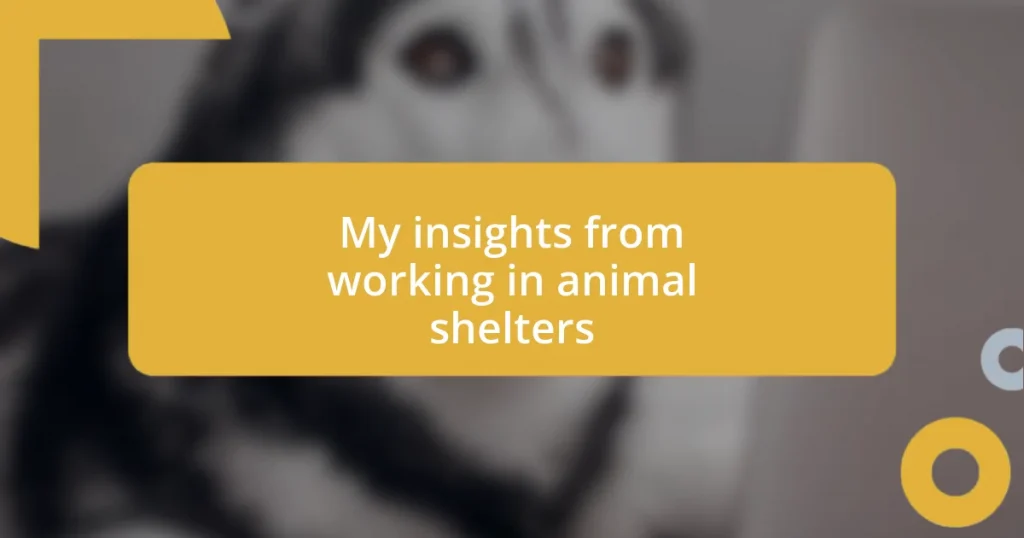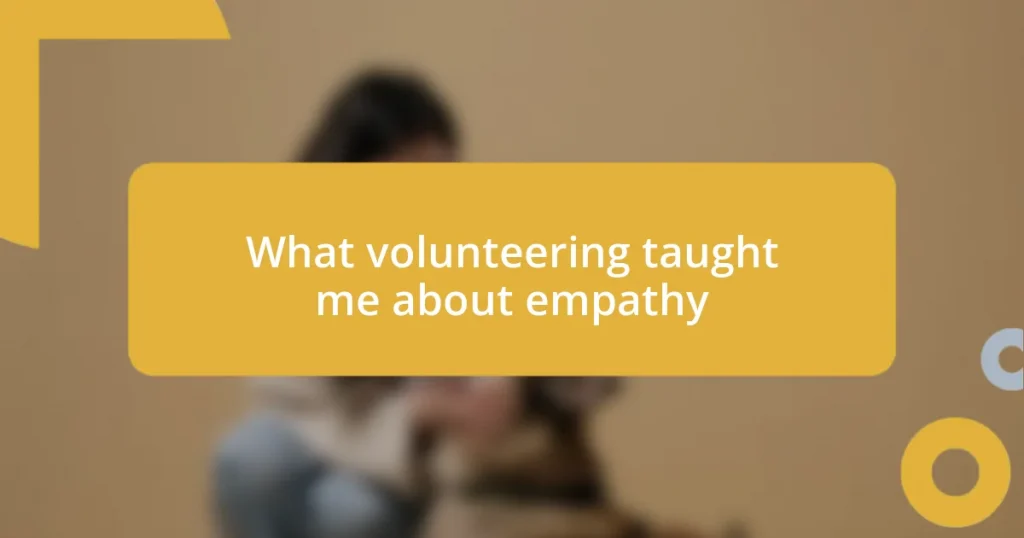Key takeaways:
- Animal shelters provide crucial support for vulnerable pets, serving as community hubs that connect animals with loving homes, reinforced by the dedication of volunteers and staff.
- Understanding animal behaviors and applying best practices, such as establishing routines and socialization, significantly enhance the chances of adoption and improve the animals’ well-being.
- Community involvement, through events and donations, greatly impacts shelter operations and fosters deeper connections between people and pets, promoting a culture of compassion and support.
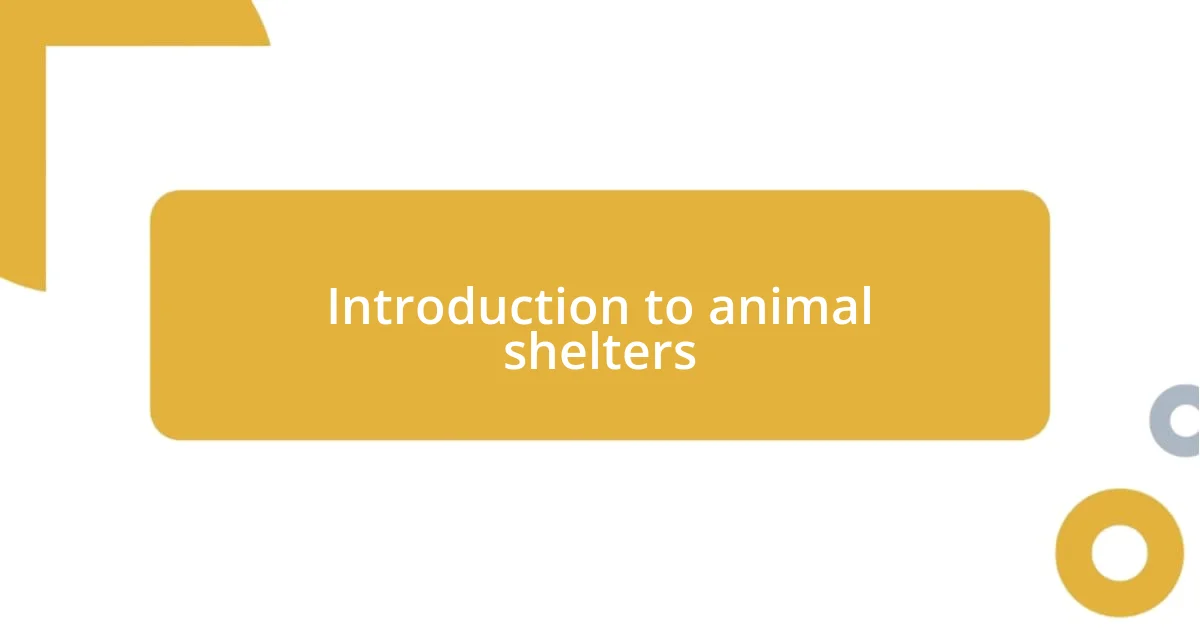
Introduction to animal shelters
Animal shelters serve as vital sanctuaries for countless vulnerable pets, often providing a second chance for those in need. From my time volunteering at a local shelter, I vividly remember the moment a shy, scruffy terrier timidly approached me. It’s astonishing how much love and resilience you can find in such a small creature.
Have you ever considered the stories behind the animals in shelters? Each one has a unique background, filled with both hardship and hope. As I listened to staff recount tales of abandonment or neglect, I couldn’t help but feel a wave of compassion. It became clear that these shelters aren’t just places for care; they are the heartbeats of our communities, tirelessly working to match animals with loving homes.
The presence of dedicated volunteers and staff in these shelters further amplifies their importance. I’ve seen the sheer dedication in their faces, the way they bond with each animal and advocate for them. It begs the question: how can we all play a part in this mission of compassion? Engaging with animal shelters can transform not only the lives of animals but also our own, filling our hearts with purpose and connection.
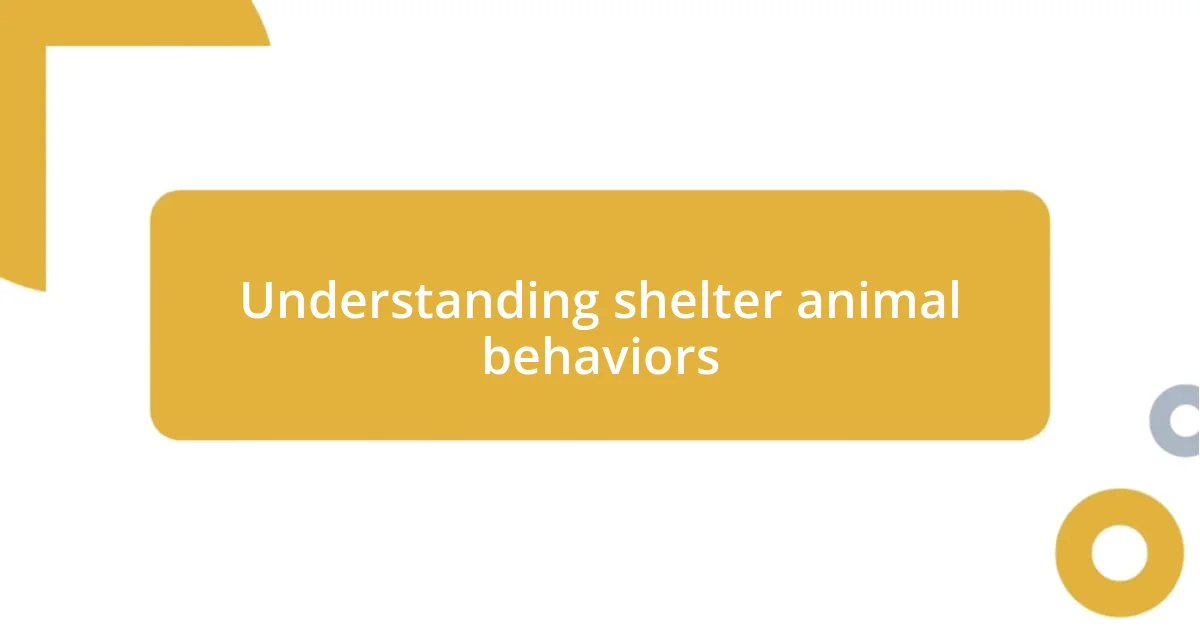
Understanding shelter animal behaviors
Understanding the behaviors of shelter animals can be both fascinating and challenging. During my time in the shelter, I quickly noticed that many animals exhibited fear or anxiety due to their past experiences. I remember a particularly nervous Labrador who would freeze at the slightest sound. It struck me how important it was to approach such animals gently and with patience, as their behaviors are often shaped by their histories.
Recognizing specific behaviors can significantly improve the animals’ chances of being adopted. Here are some key insights I’ve gathered:
- Body Language: A wagging tail isn’t universally a sign of happiness; sometimes it indicates anxiety. Understanding the nuances can help in building trust.
- Vocalizations: Barking doesn’t always mean aggression; it can also signify loneliness or a desire for attention.
- Cautious Interactions: Some animals may avoid eye contact or retreat at first; this behavior often reflects past trauma, and it’s vital to give them space and time.
- Playfulness: Engaging with toys can reveal a pet’s personality and help them overcome fear, turning a timid cat into a playful companion.
Observing these behaviors isn’t just about understanding the animals; it’s about forming connections. Each moment spent with them is an opportunity to learn and appreciate the depth of their experiences.
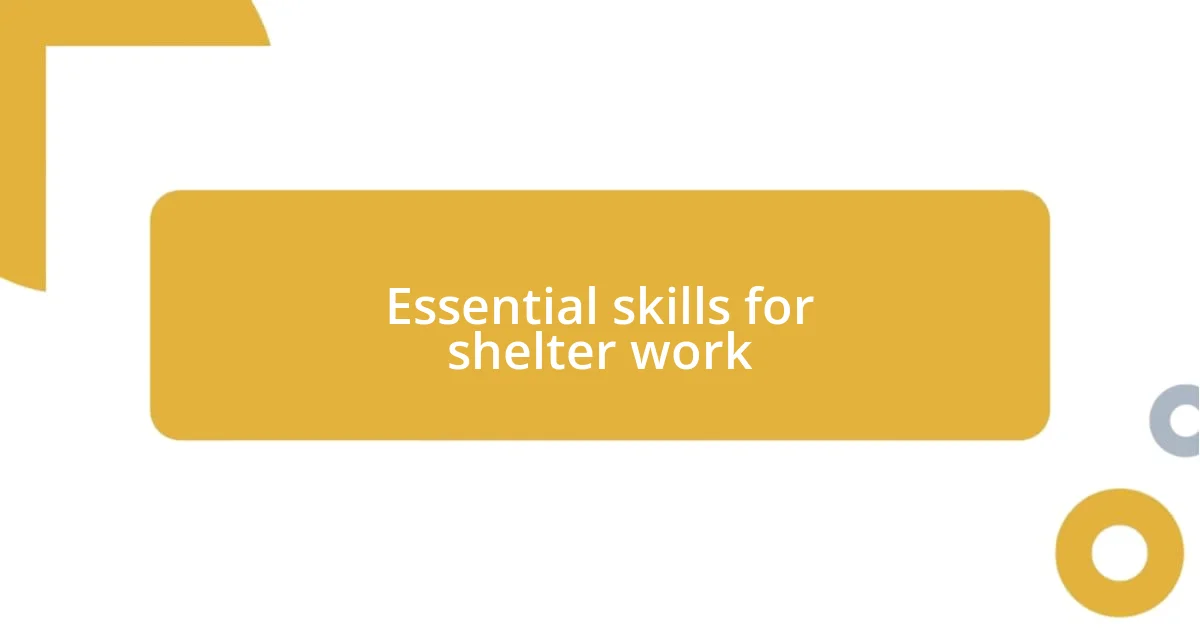
Essential skills for shelter work
Understanding the essential skills needed for shelter work can truly enhance the experience for both the staff and the animals. Communication tops the list for me; being able to articulate an animal’s needs to potential adopters can make all the difference in finding them a loving home. I remember a day when I had a long chat with a family considering adopting a shy pit bull. By sharing details about the dog’s personality and history, I helped them see past his initial nervousness and understand his potential.
Another pivotal skill is empathy. I often reflect on a moment when a cat named Mittens, who had been through a tough time, curled up in my lap. It hit me then how vital it was to connect on an emotional level with the animals, as they can pick up on our feelings. When we approach them with understanding, it fosters trust and helps them heal. This emotional component of shelter work can be incredibly rewarding, especially when you witness a previously frightened animal blossom into a confident companion.
Lastly, teamwork is crucial. I vividly remember a busy adoption event where everyone had to pitch in, from setting up booths to handling anxious dogs. The camaraderie between volunteers and staff made the event seamless and fun. Working together not only enhances the shelter’s efficiency but also strengthens bonds among team members, making the experience more fulfilling.
| Skill | Description |
|---|---|
| Communication | Effectively conveys animal needs to potential adopters. |
| Empathy | Builds emotional connections, fostering trust and healing in animals. |
| Teamwork | Enhances efficiency and camaraderie among staff and volunteers. |
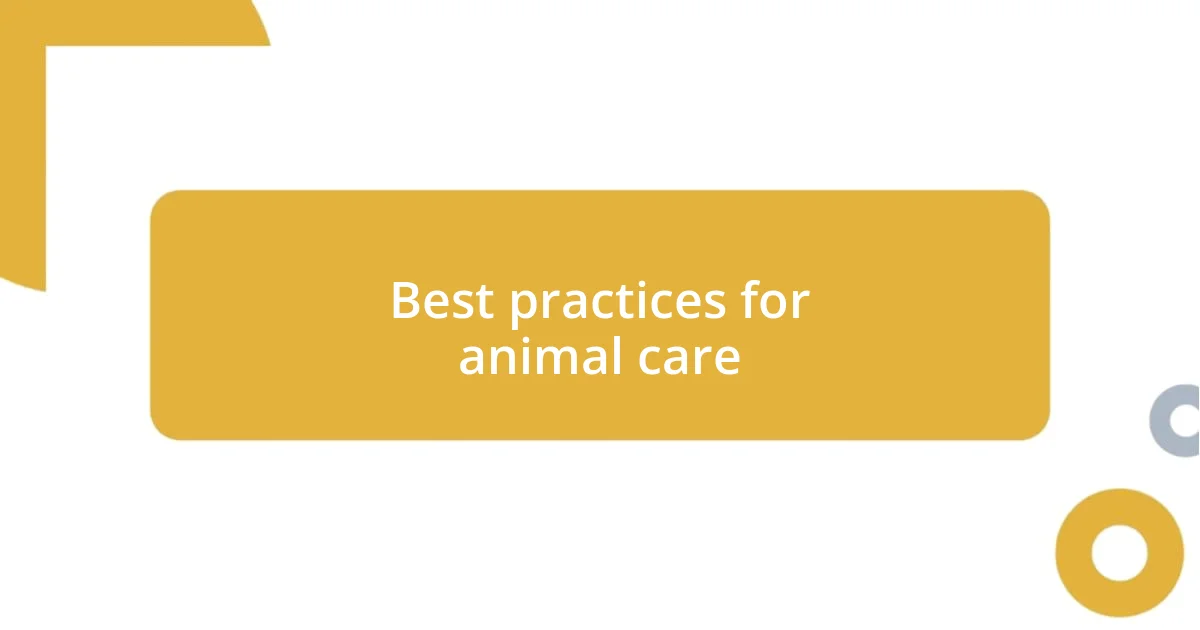
Best practices for animal care
Caring for animals in a shelter setting requires a blend of routine and sensitivity to their unique needs. One best practice I’ve learned is to establish a consistent routine for feeding and exercise. I recall a time when a particularly shy Beagle named Daisy thrived on knowing when to expect her meals and walks. It was like watching her confidence bloom each day as she realized that predictability could lead to comfort. Routine not only fosters stability but also reduces stress for these animals, allowing them to adapt more quickly to shelter life.
Another critical aspect is socialization. Animals thrive on interaction, and I’ve seen firsthand the difference it makes. One day, I took a group of playful kittens into the yard. Their laughter was contagious as they chased after butterflies, discovering the joy of the outdoors. Engaging them in play helps break down barriers and builds positive associations with humans. How many moments have you missed by not giving animals the chance to express their playful side? By incorporating regular social playtime, shelters can enhance social skills and increase adoptability.
Lastly, health and safety are paramount. Observing how animals react to different environments can provide insights into their health needs. I fondly remember a golden retriever named Max who had a hard time eating, which turned out to be due to dental issues. By addressing his health concerns, his quality of life improved tremendously, showcasing the importance of regular check-ups and attentive care. It’s essential to create an environment where these animals feel safe and secure, which ultimately prepares them for their future homes.
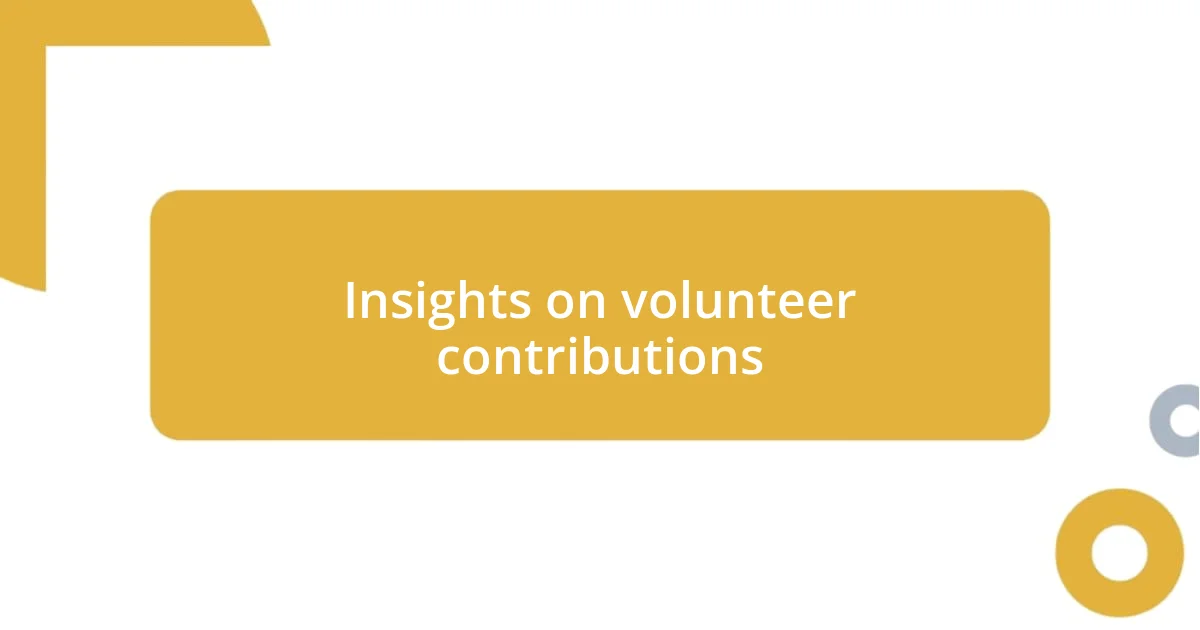
Insights on volunteer contributions
When I think about the contributions of volunteers, one vivid experience comes to mind. During my time at the shelter, I was fortunate enough to witness a group of volunteers transform our daily routines. Their enthusiasm was infectious, turning mundane tasks into spirited activities. I vividly recall one Saturday when a team of volunteers decided to organize a ‘spa day’ for our dogs, complete with baths and grooming. The joy on the dogs’ faces was priceless, and I couldn’t help but wonder if these little moments of care might ease their anxiety and increase their chances of adoption.
Volunteers also bring fresh perspectives, which can significantly enhance shelter operations. There was this time when a newcomer suggested implementing a social media campaign highlighting our long-term residents. It seemed simple enough, but the impact was profound. We found homes for several pets who had been overlooked for quite some time. This experience reinforced my belief that every volunteer has unique ideas and skills to offer, creating a ripple effect that benefits the entire shelter community.
Perhaps one of the most heartwarming aspects of volunteer contributions is the emotional support they provide—not just to the animals, but to each other and the staff as well. I still remember a quiet afternoon when a volunteer, feeling overwhelmed, stopped to help me soothe a frightened dog. Together, we sat on the floor, and she shared her thoughts about how much she cared for the animals and didn’t want them to feel alone. That moment encapsulated the power of volunteering: it’s not just about what you do; it’s about the connections you foster, both with the animals and your fellow helpers. Isn’t it incredible how those small acts of kindness can create a ripple effect of compassion throughout the shelter?
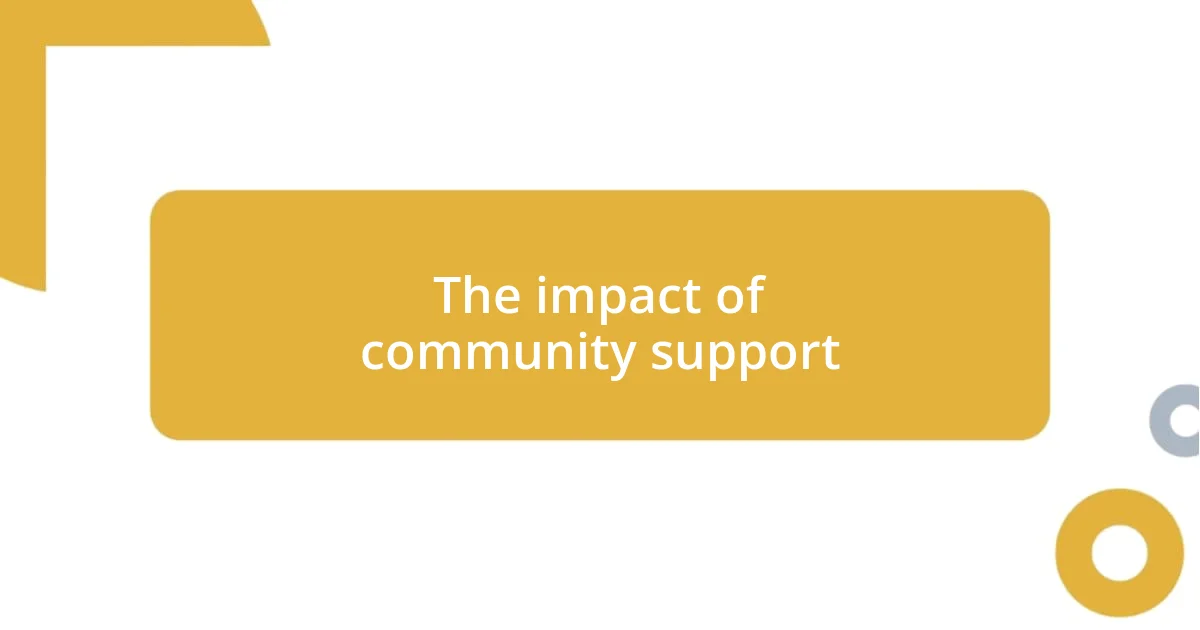
The impact of community support
Community support significantly influences the welfare of animals in shelters. I can genuinely say that during my time working at a local shelter, the involvement of community members was a game-changer. One summer, we hosted an adoption event in the park, and the turnout was astonishing. Watching families interact with our adoptable pets, I felt this palpable connection forming. It made me realize that community events not only help find homes for animals but also foster deeper relationships between people and pets.
Furthermore, the emotional and financial support from local businesses can’t be overlooked. I remember the time a nearby pet store held a donation drive for our shelter. The sheer volume of supplies they collected felt like a testament to our community’s dedication. It’s moments like these that ignite hope and remind us that every little bit helps. Have you ever felt that surge of gratitude when you realize how many people care? It’s a feeling that resonates deeply, especially when you see the direct impact of those contributions on our animals.
Finally, I often reflect on how community members volunteering their time creates a sense of belonging for both the animals and fellow staff. One particular Saturday, a group of local teen volunteers came in to help clean and socialize the cats. Their laughter echoed through the halls as they played with our feline friends. It was heartwarming to witness this blend of youthful energy and compassion. It gets me thinking: how many lives can be touched when a community rallies together? The answer, I believe, is countless.
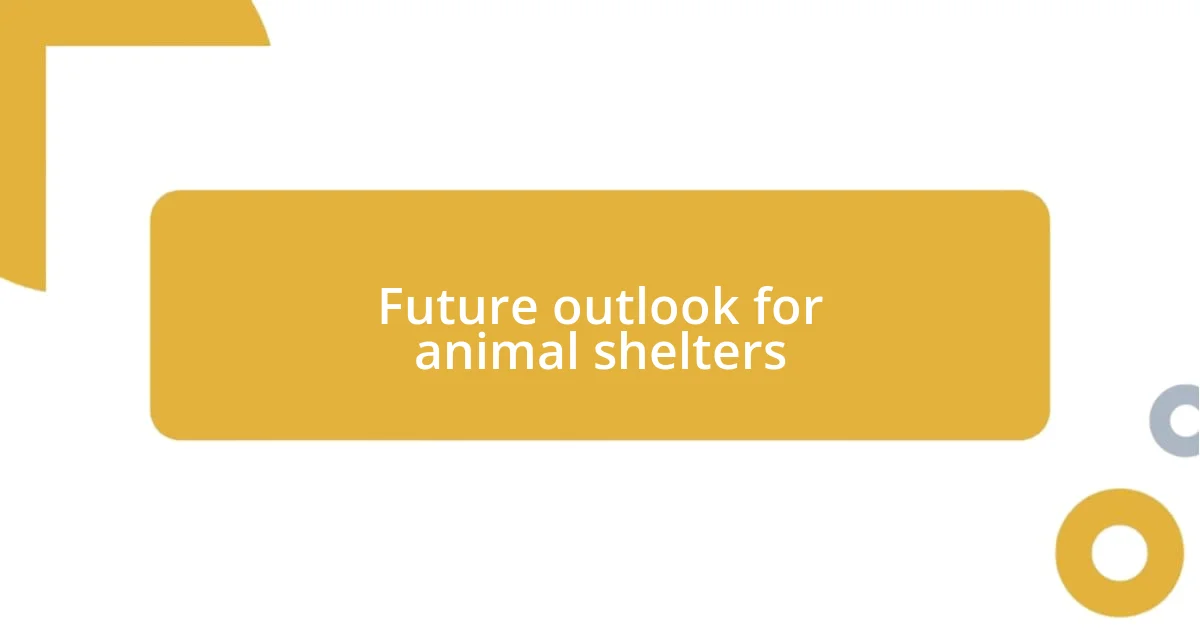
Future outlook for animal shelters
As I look to the future of animal shelters, I can’t help but feel hopeful about the potential for innovation. For example, I recently learned about the development of virtual adoption platforms, which allow prospective pet owners to interact with animals online before visiting in person. This technology could significantly expand outreach and help more animals find loving homes, especially for those in remote areas. Can you imagine how much easier it could be for someone to connect with a pet from the comfort of their own home?
There’s also a growing emphasis on mental health support for both animals and the people who care for them. I recall a time when we introduced canine behavior workshops at our shelter. Not only did these sessions enhance our understanding of animal behavior, but they also provided our staff with valuable coping strategies to manage the emotional toll of working in such a challenging environment. Investing in mental wellness resources will undoubtedly create a more uplifting atmosphere for everyone involved.
Moreover, I believe that as more people become aware of pet overpopulation, they will increasingly support initiatives like spay and neuter programs. During one outreach event, I met a couple who initially didn’t see the importance of these programs until they learned about their role in preventing animal homelessness. Their change of heart sparked conversations with their friends, creating a small but impactful movement in our community. It makes me wonder: how can individual stories like theirs collectively reshape the future of animal welfare?










